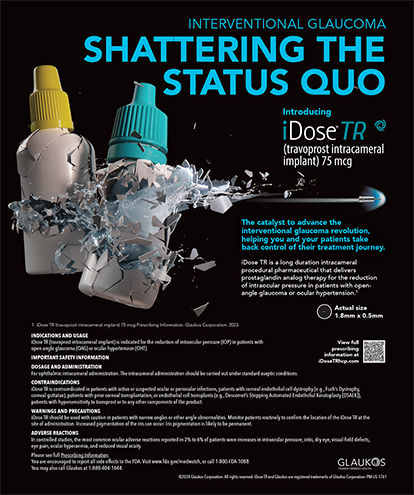
Our faces–especially our eyes–are tools that we use to communicate and connect with the world. Perceived flaws in patients’ appearances can affect how they view themselves, and self-esteem is important to personal and professional success. The primary goal of adding aesthetic options to your vision care practice is to help patients achieve their anti-aging desires for the eyelids, eyelashes, and eyebrows. This is a seamless addition for practices that already feel comfortable marketing to and educating patients on refractive surgery, IOL upgrades, and designer frames. In this article, Kimberly Cockerham, MD, outlines the aesthetics pyramid: topical health and beauty products, injectables, collagen induction therapy, and intense pulsed light therapy (IPL). With this guide, you can make informed decisions on how to offer aesthetics, depending on your preferences and resources.
—Steven D. Vold, MD

SUNBLOCK AND OTHER TOPICALS: THE FIRST TIER
The most natural starting point for aesthetics is with the optometric component of the practice. Most ophthalmologists have a referral network or their own shop, but opticians or optometrists are used to educating patients on what products are best for their needs. Integrating products that enhance the aesthetic appearance of patients’ eyes is a perfect pathway to subsequent aesthetic treatments.
Everyone is exposed to the sun, and most nongenetic aging is attributed to sun exposure. If we embrace sunblock and practices that protect our skin, we can turn back the clock and slow down time.
Colorescience has created a water-resistant, broad-spectrum sunscreen powder made of zinc and titanium, produced in a palette of varying colors and sold with a micronizing brush. Although FDA approved as sunblock, the powder appeals to women because it is packaged similarly to mineral makeup. The product includes an applicator especially for the eyelids that looks like an eye shadow wand and is particularly helpful after eyelid surgery to prevent redness, swelling, and hyperpigmentation of the incision. Because this powdered sunblock works well even when the wearer is sweating or in humid environments, it is great for men who need to protect their hairline/scalp, ears, and bearded area. Unlike lotions, the powder does not cause white discoloration and streaks. When speaking with patients about protecting themselves from ultraviolet light and sun damage, I often apply a sample to show them how it works.
Blinc offers mascaras, eyeliners, and eyelash curlers for sensitive eyes. This product line is excellent for patients with allergic conjunctivitis, meibomitis, blepharitis, dry eyes, thyroid ocular disease, and other autoimmune conditions of the eyelids. The mascara is clinically tested to be nonirritating, and it forms tiny no-smudge, water-resistant “tubes” around lashes. The mascara tubes bind to the lashes and cannot run, even if the patient cries or rubs his or her eyes. At the slit lamp, there are no particles of mascara floating in the tear film. With warm water and a gentle press from the fingertips, the tubes slide off the lashes so there is no need for a makeup remover that can be irritating. Blinc primer has conditioning properties that help the lashes grow, especially when used in conjunction with an eyelash-stimulating product such as Latisse (Allergan) or GrandeLash (Grande Naturals). These products can be helpful for patients who have undergone chemotherapy, women who are premenopausal, or men who are andropausal.

Figure 1. Baseline (A) and 3 months after three treatments with ResurFX skin resurfacing (Lumenis), with 1 month between treatments (B). Three-dimensional appearance of the cheek, before treatment (C) and after (D).
INJECTABLES: THE SECOND TIER
Muscle-relaxing and dermal-filling injectables are referred to as a liquid eyelift (or liquid facelift if used in the lower face). These quick and simple procedures can be administered with little risk to the patient and typically minimal bruising and swelling.

Figure 2. Baseline (A) and 3 months after four treatments with ResurFX skin resurfacing with 1 month between treatments (B).
The most popular injectable is botulinum A toxin purified protein, popularly known as Botox (Allergan). Botox injections temporarily paralyze muscle activity. The procedure reduces the appearance of dynamic facial wrinkles of the glabella (also known as “the 11s”), lateral canthal region (laugh lines), and—with caution—the forehead. Xeomin (Merz North America) and Dysport (Galderma) are also FDA-approved botulinum toxin A purified peptides.
Dermal fillers “fill in” nondynamic lines and augment the outcome of botulinum treatments. They can be used to fill in the temporalis fossa, the glabella if wrinkles remain after botulinum, and lines around the mouth. Dermal fillers can also be used to enhance the volume and shape of the lips and cheeks. The most popular injectables are hyaluronic acid—Perlane, Restylane (both by Galderma), and Juvederm Voluma (Allergan). Botulinum toxin and hyaluronic acid can also help restructure the region of a scar, playing a part in reducing its height and coloration.
COLLAGEN INDUCTION THERAPY: THE THIRD TIER
In microneedling, a device delivers tiny needle pricks to stimulate the skin’s natural healing processes. The device has rollers with wheels of needles and pens with a cluster of needles at the tip. The injury caused by the needles stimulates collagen growth, which minimizes wrinkles and improves the appearance of scars. The device can be purchased by patients and used at home. Microneedling can also be augmented with injections of fat-derived stem cells and growth factor induction using autologous blood-derived, platelet-rich plasma to draw in positive growth factors and cytokines to enhance the skin’s appearance and hair growth.

Figure 3. Baseline (A) and 3 months after four treatments with ResurFX skin resurfacing with 1 month between treatments (B).
LASERS: THE FOURTH TIER
Laser therapy can improve the overall look of the face. Among the lasers on the market, I have found that the M22 IPL laser (Lumenis) is a unique technology that combines IPL treatment with nonablative fractional and Nd:YAG lasers in one device. The system has three modules. The IPL module uses SapphireCool Light Guides for continuous cooling to maximize patients’ comfort during the procedure, and it minimizes the appearance of pigmented lesions, unwanted hair, vascular lesions, rosacea, sun damage, fine lines, and wrinkles. A second module, ResurFX, uses a fiber laser and scanner for nonablative skin resurfacing and treats pigmentation problems, age spots, fine lines, wrinkles, acne, surgical scars, textural irregularities, and lax skin (Figures 1-3). Finally, the Nd:YAG module uses multiple sequential pulsing to allow cooling between pulses, and it treats vascular lesions, veins, and superficial wrinkles. The laser treatments are typically done in the clinic or ambulatory surgery center. Treatment time varies depending on the extent of areas treated (range, 5-30 minutes). Lasers can be effective for myriad conditions and augment the actions of topical therapeutics, injectables, and nonlaser collagen induction.
CONCLUSION
I treat patients who have serious conditions including cancer, trauma, and devastating autoimmune diseases. Their journey to wellness is often stressful and lengthy. I have noticed during my 2 decades in practice that patients and their families enjoy having control over something. This might be a new pair of colored contacts, cool sunglasses, long eyelashes, or the erasure of a line or scar. I love the joy on their faces when they make the choice and are happy with their appearance. I am offering them a way to have an immediate impact on their appearance and self-esteem when they have lost control over their medical condition or feel socially or professionally challenged. n
Kimberly Cockerham, MD
• physician and surgeon in private practice located in Lodi, Stockton, Modesto, Tracy, and San Ramon, California
• cockerhammd@gmail.com
• financial disclosure: paid consultant to and lecturer for Lumenis
Steven D. Vold, MD
• cataract and glaucoma surgery consultant at Vold Vision in Fayetteville, Arkansas
• chief medical editor, CRST’s sister publication Glaucoma Today
• svold@voldvision.com
• financial disclosure: consultant to Lumenis


